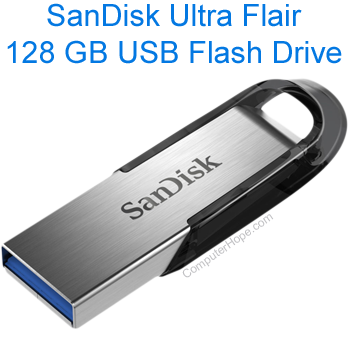Flash drive

Alternatively known as a jump drive, USB flash drive, data stick, pen drive, memory unit, keychain drive, and thumb drive, a flash drive is a portable storage device. It's the size of a human thumb (hence the name) and connects to a computer via a USB port. Flash drives are an easy way to store and transfer information between computers and range in size from 2 GB to 1 TB.
Unlike a standard hard drive, the flash drive has no movable parts; it contains only an integrated circuit memory chip to store data. Flash drives usually have plastic or aluminum casings surrounding the memory chip. The picture shows a SanDisk Cruzer Micro 16 GB flash drive.
Some may call an SSD (solid-state drive) a flash drive.
Flash drive was featured as a top term of 2003.
How to use a flash drive
A flash drive can be utilized like any drive on your computer. To save a file to your thumb drive, follow the steps below.
Except for USB 3.0, all USB connectors can only connect in one direction. If you're having trouble inserting the USB drive, try rotating the drive 180 degrees.
- Once inserted, open My Computer or File Explorer in Windows to see the drive labeled as "Removable Disk," "Flash drive," or as the manufacturer's name.
- Once the appropriate drive letter for your device is determined, you can copy any file and paste it onto the flash drive. You can also drag-and-drop files onto the flash drive.
If you're having trouble locating the drive letter of your flash drive, take a look at the next section.
What drive letter is my flash drive?
When connecting a flash drive to a computer on Microsoft Windows, it becomes the first available drive letter after those already in use. For example, if your hard drive is C: and your disc drive is D:, your flash drive would likely be the E: drive. An exception to this rule would be if you have more than one hard drive. If you are still unsure, open File Explorer, and watch for a new drive to appear after you insert the thumb drive.
What is the difference between a jump drive and a flash drive?
A jump drive and a flash drive are the same but with different names. The confusion seems to arise in the difference between a flash drive, a device (detailed above), and flash memory, a non-volatile storage medium. Flash memory is used in many devices, including flash drives, solid-state drives, and memory cards.
How are USB flash drives used?
The USB flash drive stores and transfers files between computers. For example, you could write a report using a school computer, copy the file to your USB flash drive, and later connect it to your home computer to continue working. USB flash drives are also a great and easy way to back up important files. For example, you could copy all your pictures, documents, music, or other files to a flash drive and store it somewhere safe in case something happens to your computer.
Like all past storage media, flash drives are now being replaced by cloud storage. If you are looking for faster methods of transferring data, you can use cloud storage as an alternative method.
What did people use before flash drives to store data?
Before the popularity of flash drives, most people used recordable CDs and DVDs to store and back up data.
How much data can a flash drive hold?
Currently, flash drives hold between 8 GB and 2 TB of information.
How big of a flash drive should I get?
Today, even a 16 GB flash drive is not that much money, and we recommend buying as much as you can afford. However, if you are only planning on storing a few document files, save money by buying a smaller drive.
History of the USB flash drive
The first USB flash drives were developed in April 1999 at M-Systems (now SanDisk), an Israeli company, by Amir Ban, Dov Moran, and Oron Ogdan. M-Systems announced the USB flash drives in September 2000 and were first sold to the public in December 2000 by IBM, with a capacity of 8 MB.
Drive, External storage, Hard drive terms, Hardware terms, Memory terms, Non-volatile, OTG adapter, Portable, Solid-state device, SSD, Stick, USB
